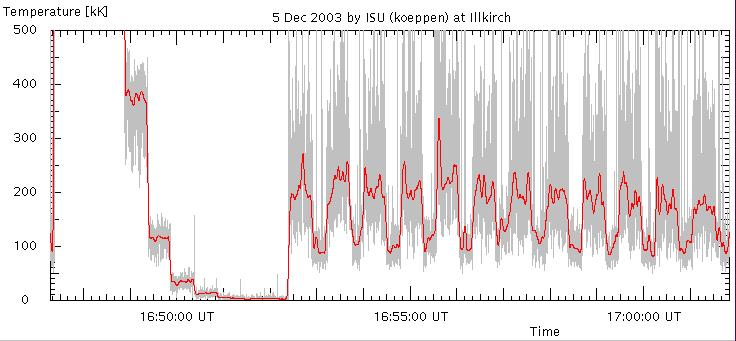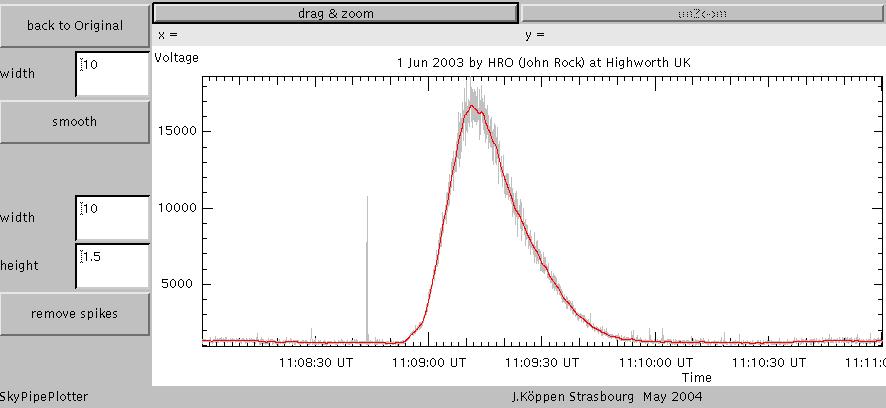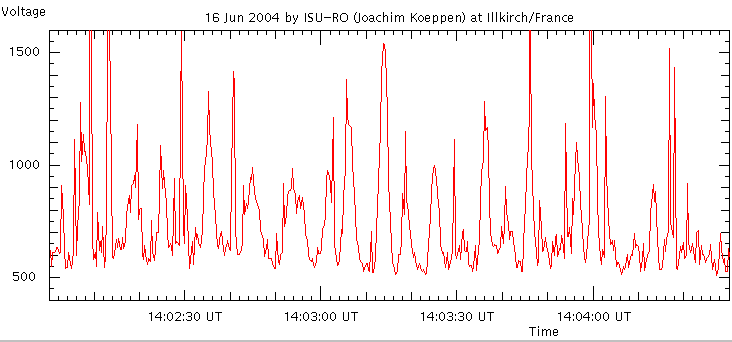
Local Problems for RadioJove at ISU
Joachim Köppen DF3GJ Kiel/Strasbourg/Illkirch Spring 2004
The worst and most persistent problem is that of a period noise interference which commences when the street lamps are switched on in the evening, and stops when they are switched off in the morning. Thus, any night time observations for Jovian emission are seriously hampered. A typical emission looks like this in the raw data:

To the left, there is the sequence of calibration steps, but to the right the almost strictly periodic increase of noise is apparent. During the interval of high signal one also notes an unpleasant sharp hissing in the audio signal which is unlike the hiss from a noise generator. The period is measured as about 47 seconds, there is some minor variation of this value. Since we noticed that one of the sodium vapour street lamps in front of the ISU building was often seen flashing, a study revealed that it did so with the same period. Some nights, the level of interference showed variations in strength, sometimes even it stopped for some minutes. This interference was not present in the first days in january, but hope that the problem had solved itself were shattered with the resumption of the emission. Later, the periodic behaviour changed into leaving out one or a couple of low emission. We called the local council to replace what was apparently a bulb at the end of its lifetime, the bulb was replaced, but after a couple of days the same type of emission reappeared. Again, some nights were without any emission... We are still hunting for the origin...
With the calibration, we can give the noise levels in temperature (this plot has also been processed to remove narrow spikes and noise fluctuations, as explained below)

The emission thus switches from a low state of about 100 kK to a high state of about 200 kK. We note that the exspected background from the MIlky Way is about 50 kK, with Jovian signals about 10 to 30 times higher. Thus, one might hope to catch Jupiter during the low state, but it would be better to have that interference eliminated...
The spikes on the plots caused by short radio impulses, created by electric discharges and computers, can be removed by software, in the SkyPipePlotter program. The technique is to check every datum whether it lies above a straight line connecting data 10 pixels apart ("width"); if it does so by more than a factor (1+height) of the current y-value, the datum is replaced by the value predicted by the straight line. Smoothing is done simply by averaging over the "width" pixels left and right of each pixel. One fiddles with these three parameters, until one obtains what one accepts as a nice result... To show that such a software can fully remove narrow spikes, I display the observations of a solar burst, taken by John Rock in England:

The raw data, shown in grey, is first processed to remove the narrow spike, then we also smooth it to remove the fluctuations on the signal from the noise. The resulting curve is shown in red.
Recently, I came across another phenomenon: As I was listening, a noisy
mechanical, throbbing sound - like the awful noise used by jamming transmission
during the cold war period - came up and faded again in a fairly regular
way, with a period of a few seconds. Since transmissions with this sound
are often heard on short waves at various frequencies - but not in the
broadcast bands! - they are obviously a kind of data transmission, though
I do not yet know the proper name.
This transmission I could hear independent of the tuning of the Jove receiver,
so it obviously was a strong signal on a nearby frequency which caused
overload of the mixer. The ups and downs in its volume were simply the
almost periodic fading which occurs usually when the reflectance
of the ionosphere changes as its ionisation decays at dusk or builds up
at dawn. The signal was probably only a few 100 kHz away from the centre
of the filter's passband, so whenever the signal became strong, it could leak
through into the receiver...
The plot showed a regular series of rather broad peaks which one could
have identified as interesting solar bursts:

| Top of the Page | back to Main Page | back to my Home Page |